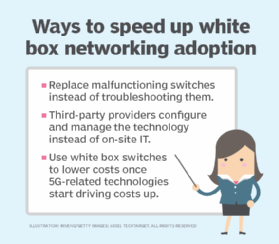
Getty Images/iStockphoto
Ways to speed up white box networking adoption
Most organizations are slow to deploy new techniques, white box networking included. Experts explain why and offer advice on how to speed up adoption across enterprises.
Modern networking has grown complex in recent years. Efficient network infrastructure demands agility, high bandwidth capability and support for high-capacity routers, switches and data, among other requirements. As networks become more innovative, so too must the methods teams use to operate them.
White box networking provides one such strategy to enable efficiency and network customization. Hardware and software are traditionally sold in one integrated package from a single vendor. Most OSes are incompatible with unassociated hardware, so customers must purchase the corresponding hardware to work with their preferred software.
But white box networking decouples hardware and software technology. Teams can build networks with white box switches and choose which network operating system (NOS) they want to use. Because the NOS is sold separately from the network hardware, teams can customize which software to use with their preferred hardware and avoid vendor lock-in.
It would stand to reason, then, that white box networking would be a widely deployed networking strategy. However, adoption of white box networking has developed slowly across most enterprises. According to analysts, enterprises are reluctant to make the switch from proprietary to open hardware because of difficulties with integration and unsupported switches.
Complexities with hardware and software
One reason why white box networking adoption has been slow is because of the complexities associated with the technology, said Rohit Mehra, group vice president of network infrastructure at IDC. Unlike proprietary switches, which function for one sole purpose, white box switches are not prepackaged with installed software. IT teams must figure out what kind of NOS to install, which is often complicated.
 Rohit Mehra
Rohit Mehra
"Integrating the hardware with the software -- and then within the software, what options to choose, what network, policy or security applications to run on top of the operating system -- is somewhat complex," Mehra said. "Not every IT department is prepared to take on that kind of integration role."
White box networking is most popular with hyperscale cloud providers, such as AWS, Google and Microsoft Azure, and large enterprises. Because of their size, these organizations have more resources to handle potential integration complexities.
But white box networking hasn't been completely abandoned by enterprises. White box switches comprise a global, billion-dollar market, although enterprises make up a small share. "Less than five to seven percent of the consumption is among the enterprise community," Mehra said.
Limited support from third-party vendors
Third-party vendors offer minimal support for white box switches, which is a large reason why enterprises are reluctant to change to white box networking, according to Bob Laliberte, practice director and senior analyst at Enterprise Strategy Group, a division of TechTarget.
"In a lot of cases, it comes down to the fact that organizations feel more comfortable going with a complete and comprehensive package," Laliberte said.
 Bob Laliberte
Bob Laliberte
White box switches are a form of commodity hardware, so they lack the support available for traditional switches. Typical switch vendors provide support for both their hardware and software systems. It's difficult to receive the same level of support for white box switches because of the ambiguity around which vendor owns the system, Laliberte said.
Enterprises also have existing relationships with vendors, which further complicates white box networking adoption, Laliberte said. "When you've got an incumbent vendor, it's not only the cost of the solution, but what's the cost to change," he said.
Changing from a current vendor to a new strategy such as white box networking requires teams to analyze not only the cost of the technology, but also the cost of changing from a previous plan, he added.
White boxes are cheaper alternatives to vendor-supplied proprietary switches, which is one of its main draws. When adding the cost of support from third-party vendors, however, the total cost of ownership of white box switches sometimes ends up being more expensive than the previous system.
"Sometimes it's just easier for people to keep going with what they have, [even] if it's not the most cost effective," Laliberte said.
How to accelerate white box networking adoption
Despite the cost-effectiveness of white box switches and the potential benefits gained from open networking, most enterprises don't use white box networking due to complexity and limited support. However, some strategies could speed up adoption.

Mehra said that if NOS providers packaged their systems in a "consumable, IT-centric manner," it would simplify deployment from an operational simplicity perspective. Smaller enterprises with less equipped IT teams could benefit from this because the NOS vendors would configure the systems instead. Also, if third-party vendors configured the systems, network teams could receive ongoing support from those vendors when running into any issues.
From the opposite perspective, Laliberte said white box networking adoption could happen quicker if organizations mimic hyperscale environments. An enterprise could purchase and implement several inexpensive switches that are deployed or removed at will.
"[They can] just have a ton of cheap, reliable switches that they can easily swap out," Laliberte said. If a switch malfunctions, they won't have to worry about troubleshooting the hardware because they can easily replace it.
Another option, Laliberte said, could be for enterprises to deploy more applications as a service. "As long as it's being delivered as a service, it really doesn't matter what the underlying technology is, as long as they're meeting their [service-level agreements]."
White box networking could also pick up steam once 5G networking is fully implemented. 5G has the potential to power new architectures that will most likely increase operational costs. Laliberte said enterprises may look to deploying white box switches to lower costs if this happens.








